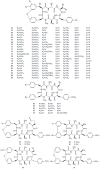A Review of the Botany, Phytochemistry, Pharmacology and Toxicology of Rubiae Radix et Rhizoma
- PMID: 27999402
- PMCID: PMC6274022
- DOI: 10.3390/molecules21121747
A Review of the Botany, Phytochemistry, Pharmacology and Toxicology of Rubiae Radix et Rhizoma
Abstract
Rubia cordifolia Linn (Rubiaceae) is a climbing perennial herbal plant, which is widely distributed in China and India. Its root and rhizome, Rubiae Radix et Rhizoma (called Qiancao in China and Indian madder in India), is a well known phytomedicine used for hematemesis, epistaxis, flooding, spotting, traumatic bleeding, amenorrhea caused by obstruction, joint impediment pain, swelling and pain caused by injuries from falls. In addition, it is a kind of pigment utilized as a food additive and a dye for wool or fiber. This review mainly concentrates on studies of the botany, phytochemistry, pharmacology and toxicology of this Traditional Chinese Medicine. The phytochemical evidences indicated that over a hundred chemical components have been found and isolated from the medicine, such as anthraquinones, naphthoquinones, triterpenoids, cyclic hexapeptides and others. These components are considered responsible for the various bioactivities of the herbal drug, including anti-oxidation, anti-inflammation, immunomodulation, antitumor, effects on coagulation-fibrinolysis system, neuroprotection and other effects. Additionally, based on these existing results, we also propose some interesting future research directions. Consequently, this review should help us to more comprehensively understand and to more fully utilize the herbal medicine Rubiae Radix et Rhizoma.
Keywords: Rubiae Radix et Rhizoma; botany; pharmacology; phytochemistry; review; toxicology.
Conflict of interest statement
The authors declare no conflict of interest.
Figures
References
-
- Chinese Pharmacopeia Commission . Pharmacopoeia of the People’s Republic of China. Volume 1. Chinese Medical Science Press; Beijing, China: 2015. pp. 234–235.
-
- Akhtar M.S., Ali M., Madhurima, Mir S.R., Singh O. New anthraquinones from Rubia cordifolia roots. Indian J. Chem. B. 2006;45:1945–1950. doi: 10.1002/chin.200701211. - DOI
-
- Chen X.Q., Zhao S.M., Wang Z., Zeng G.Z., Huang M.B., Tan N.H. Rubicordins A-C, new cyclopeptides from Rubia cordifolia with cytotoxicity and inhibiting NF-κB signaling pathway. Tetrahedron. 2015;71:9673–9678. doi: 10.1016/j.tet.2015.10.044. - DOI
-
- Hitotsuyanagi Y., Kusano J., Kim I.H., Hasuda T., Fukaya H., Takeya K. O-Seco-RA-XXIV, a possible precursor of an antitumor peptide RA-XXIV, from Rubia cordifolia L. Phytochem. Lett. 2012;5:335–339. doi: 10.1016/j.phytol.2012.02.014. - DOI
Publication types
MeSH terms
Substances
LinkOut - more resources
Full Text Sources
Other Literature Sources





